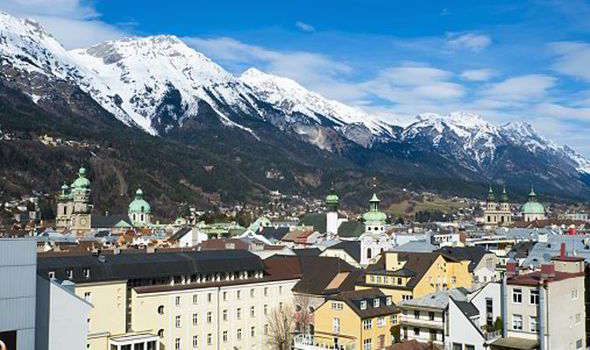
Innsbruck in Tyrol, Austria, is much more provincial than Vienna or even Salzburg. However, this beautifully located city has several sights worth seeing. Sightseeing highlights include the lovely old town, the permanent presence of the Alps, palaces, churches, museums, castles, and winter sport facilities.
The Innsbruck Card, sold by the tourist information office, gives admission to most major sights in Innsbruck as well as unlimited use of public transportation. It is available for 24, 48, or 72 hours. It pays itself very fast if cable cars are used. Without taking into account transportation or the use of cable cars, admission to all sights listed below equals the price of a three-day Innsbruck Card.
Top Sights in Innsbruck’s Old Town
Innsbruck has a lovely old town with a large pedestrian area. Numerous outdoor restaurants and coffee shops invite visitors to linger longer in the mostly Gothic streets.
Innsbruck’s Goldenes Dachl (Golden Roof)
The best-known sight in Innsbruck is the Goldenes Dachl (Golden Roof). This golden canopy on top of a spectators’ gallery dates from around 1500 and was built by Holy Roman Emperor Maximilian I (ruled 1493 to 1519).
The Golden Roof is at the T-junction of Maria-Theresien-Straße and Herzog-Friedrich-Straße and can be appreciated from any of these streets. The building itself houses the Maximilianeum, a small museum on the life of Maximilian. It is no longer possible to actually go onto the balcony covered by the Golden Roof.
The nearby Stadtturm (Belfry) partly dates from the fourteenth century and offers excellent views. Across the road is the Helblinghaus – a rare example of Rococo in an otherwise mostly Gothic old town.
The Innsbruck Hofburg (Imperial Palace)
Just around the corner from the Goldenes Dachl is the Hofburg (Imperial Palace), which served as residence when the Habsburg emperors visited Innsbruck. Although interesting, it pales in comparison to the lavish palaces in Vienna and Southern Germany and can be seen in 20 minutes.
The local branch of Café Sacher is inside the Hofburg – an excellent upmarket choice for coffee and cake.
The Mausoleum of Maximilian I (Grabmal Kaiser Maximilians I)
More interesting and one of the best examples of German Renaissance sculpture is the Mausoleum of Maximilian I (Grabmal Kaiser Maximilians I). The large tomb with a life-size statue of Maximilian himself on top of the tomb and 28 larger-than-life statues surrounding it is in the Hofkirche (Imperial Court Church) – enter through the Tiroler Volksmuseum (Tyrolean Folk Art Museum).
The lavish grave is empty though. When the time came, Maximilian was so indebted to Innsbruck that the city refused his entourage entry and he was thus buried in Wiener Neustadt near Vienna.
Going up the Nordkette Mountains
The Alps can be seen from almost any vantage point in the Old Town. Going to the top of the mountains is easy, if somewhat expensive. Several options are available but the most popular is ascending the Nordkette Mountains right to the north of Innsbruck.
A funicular goes from the south bank of the Inn River to the Hungerburg (this area can also be reached by car or on foot). From here, a cable car goes all the way to the top of the Hafelekar peak (2,334 m / 7,657 ft) in the Nordkette Mountains.
Bergisel Ski Jump Arena in Innsbruck, Austria
Innsbruck hosted the Winter Olympic Games in 1964 and 1976. Not surprisingly, the city’s winter sport facilities are impressive. The most popular for visitors is the ski jump arena building at Bergisel, which was rebuilt in 2002 to designs by Zaha Hadid.
An elevator zooms visitors up to the top of the around 50 m high building in two minutes. From here, visitors can enjoy excellent views from the very modern coffee shop of not only the ski jump itself but also Innsbruck, the Inn Valley and the routes leading to the Brenner Pass.
Schloss Ambras Castle near Innsbruck
Schloss Ambras is to the south of Innsbruck and was the residence of the archdukes of Tyrol. The best buildings and art here are from the sixteenth century.
Several buildings are open to visitors and the whole Ambras complex can be seen without guided tours. The museum has sets of armor and other knight-related displays that can be enjoyed by children too.
The Spanish Hall is a 43-m banqueting hall – one of the finest examples of Renaissance architecture north of the Alps. The older Hochschloss (Upper Castle) has an art museum – mostly portraits by notable artists of the Austrian nobility. The courtyard has interesting Renaissance black-and-white frescoes.


